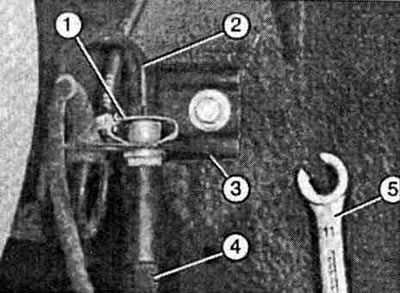Most brake hoses are fixed with a holder (metal bracket) from slipping. When installing, do not forget about the holder.
When installing, first tighten the side with the external thread. Then secure the other side of the brake hose with the union nut.
Never mount a brake hose twisted. You will determine the correct location by a solid colored band, a rubber influx or a rubber profile along the hose.

If the brake pipes 2 and brake hoses 4 are connected to the chassis or body parts with a metal holder 3, the spring holder 1 must not be forgotten. To open such a connection, a wrench 5 for the brake tube is suitable, covering the entire nut of the tube.
Bleed the air from the brake system as described above.
Be sure to check whether the brake hose has the required free play even during damping movements. If not, move the spacer accordingly. Check the free play again after a long drive.

Front brake hose
This way the brake fluid won't leak out
If you disconnect the brake pipe (brake hose), the brake fluid will slowly flow out of the expansion tank. This will not happen if you loosen the bleed valve of the corresponding brake circuit and put on the bleed hose before work. Lower the free end of the hose into a clean vessel and depress the brake pedal to the stop. Then fix the brake pedal to the floor with a wooden rail or a suitable weight. Now the supply holes in the GTZ are closed - the brake fluid can no longer flow out.
Visitor comments